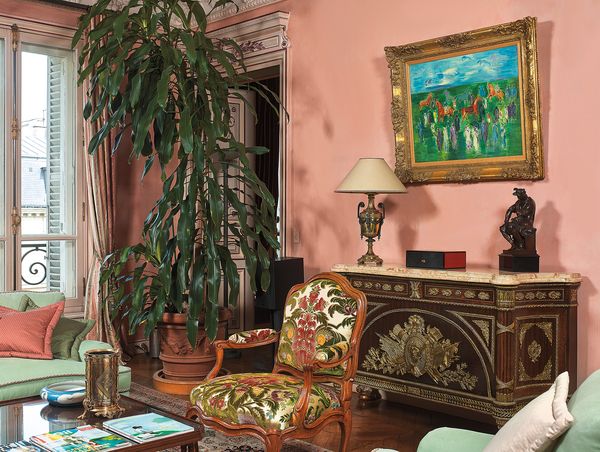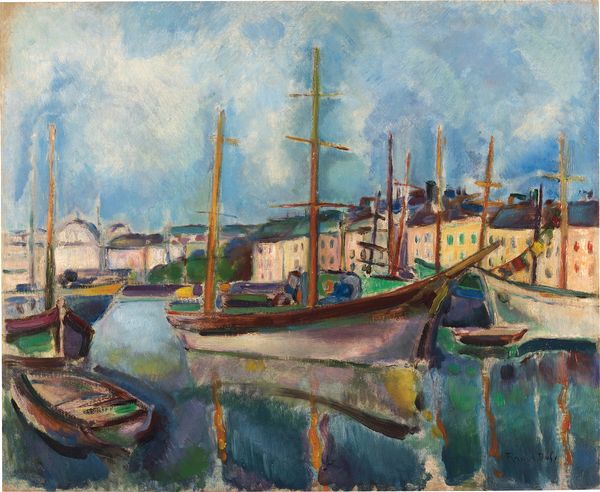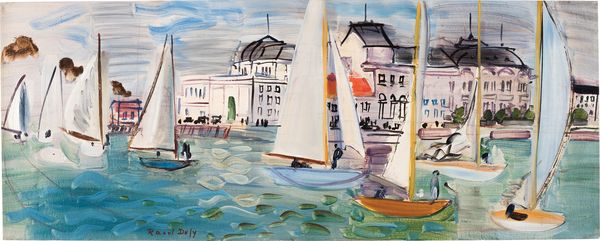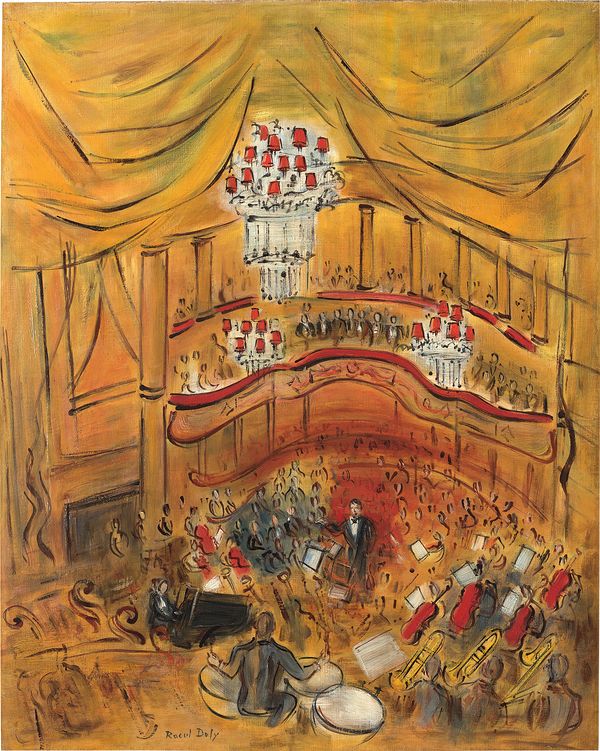Interior of the private French collector's residence depicting Raoul Dufy Chevaux, jockeys et élégantes, circa 1950
Though Raoul Dufy interacted with and was influenced by the contemporaneous currents in art, including Fauvism and Cubism, he maintained his independence as an artist and forged his own path to develop an aesthetic that is distinctly and enduringly his own. His entire oeuvre can be viewed as an aspiration towards light and his serenely painted renderings of nature and people are imbued with irony, grandeur and wit. Characterized by the artist’s love for all that is vibrant in life, the works in this impressive group span his influential career and demonstrate many of the themes Dufy explored with his graceful, poetic charm.
Raoul Dufy Le port du Havre, 1906
Painted in 1906 at the height of his Fauve period, Le port du Havre showcases Dufy's lifelong love of the sea and his distinct use of color. Born in Le Havre, the Normandy port town depicted in the present work, Dufy owed his love of the sea to the city where he spent all of his childhood and adolescence. The years of 1906-07 saw a period of intense experimentation for Dufy when he first coined his theory 'couleur-lumière', which he would apply to his entire oeuvre: "I was spontaneously led towards what was to become my real preoccupation. I had discovered a system, whose theory was this: to follow the light of the sun is a waste of time. Light in painting is something completely different: it is a light distributed throughout the composition, a 'couleur-lumière'" (the artist, quoted in Dora Perez-Tibi, Dufy, New York, 1989, p. 24).
In the summer of 1906, Dufy worked alongside Albert Marquet, one of the original Fauves, in the seaside towns of Le Havre, Trouville and Honfleur. Marquet guided the artist during these months as Dufy experimented with color to depict a departure from reality, using it in an expressive, rather than descriptive, technique. The rich chromatism that Dufy developed during this period is evident in Le port du Havre in the bright green, orange and purple hues that highlight the boats and the windows of the portside buildings. Though Dufy's Fauve period was brief, spanning only the years of 1906-07, the artist retained the stylistic qualities that he learned during this time, such as the paring down of subjects and his taste for color, applying them to his work throughout his career.
Raoul Dufy Régates à Deauville, 1934
The theme of the regatta first appeared in Dufy's work in 1907 and would appear time and time again throughout his practice, set against a backdrop of different towns across France and England. Dufy considered the sea a backdrop for activities and lively spectacles, and the ultimate location to observe the effects of light: "Unhappy the man who lives in a climate far from the sea, or unfed by the sparkling waters of a river!…The painter constantly needs to be able to see a certain quality of light, a flickering, an airy palpitation bathing what he sees" (the artist, quoted in Dora Perez-Tibi, Dufy, New York, 1989 p. 158). In Régates à Deauville, painted in 1934, sailboats with billowing crescent sails, bathed in light, race by grand buildings on the quai on the far side of the shore. The horizontal brushstrokes of the expressive sea and sky enhance the sense of movement as the boats enter the composition at the left and then pass by the viewer in our implied position as spectator. Detail is sacrificed in favor of broad strokes that capture the general impression of the scene, allowing one to be easily immersed into the light-hearted activities.
Raoul Dufy Le Grand Orchestre, circa 1946
Le Grand Orchestre, executed circa 1946, showcase Dufy's unwavering passion for music, which he inherited from his father, an amateur musician and organ player, who inspired a passion for music in all of his children from an early age. In Dufy's representations of musicians, compositions are transposed into pure musicality, reflecting his deep understanding and appreciation for this form of art, so much so that his friend Pablo Casals told him: "I cannot tell what piece your orchestra is playing, but I know which key it is written in" (Pablo Casals, quoted in Dora Perez-Tibi, Dufy, New York, 1989, p. 292). In Le Grand Orchestre, the composition, flanked by the theater's wings and centered by the impressive chandelier overhead, appears to be floating on a sumptuous yellow surface that inhabits the entire canvas. The simplified forms of the audience, musicians and instruments evoke musical notes on a staff and convey a palpable sense of rhythm across the work.
Raoul Dufy Nu dans l'atelier de la place Arago à Perpignan, circa 1946
Nu dans l'atelier de la place Arago à Perpignan, from the same year, 1946, belongs to a series of nudes depicted in Dufy's study, begun decades prior in 1909. Though this subject did not play a major role in Dufy's oeuvre, it served as a means of uniting two traditional themes conceived in a distinctly modern aesthetic - the nude and the artist's studio - and marked the development of his style as he returned to this model throughout his career. The studio acted as a representation of the mental space in which the artist’s work occurred, and, fittingly, the scene depicted in Nu dans l'atelier de la place Arago à Perpignan is composed of bright colors and is bathed in light from the large window at the left side of the composition. A tenderly portrayed, relaxed woman reclines on a chaise-lounge at the center, while the easel to her right holds an unfinished painting, suggestive of the artist's presence in the room.
The window overlooking the town visually increases the dimensions of the studio, endowing it with an airy and spacious feeling characteristic of Dufy’s interiors, and his studio in the Place Arago in Perpignan, where he worked from 1946-51, depicted in the present work, is the apotheosis of this theme.




